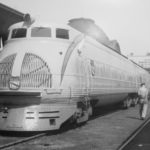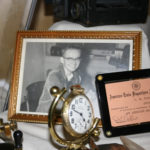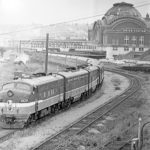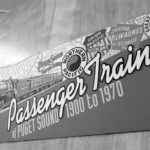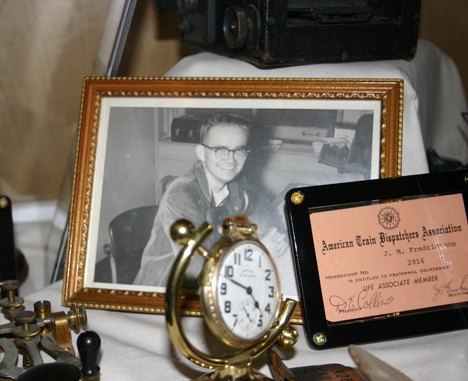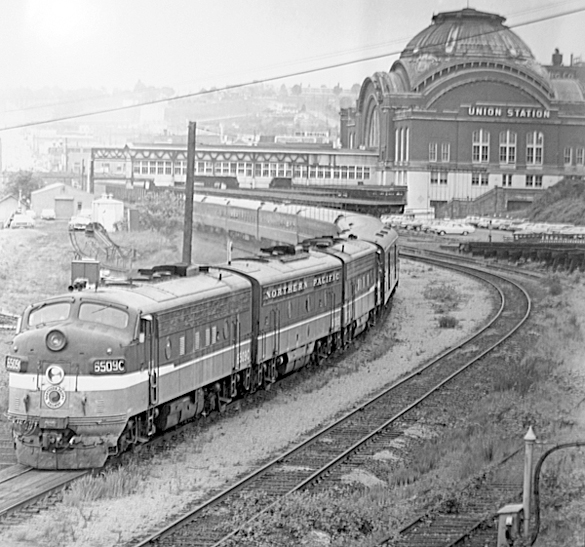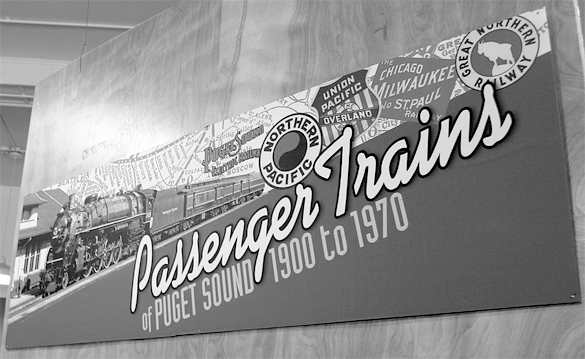In the early-1940s, as a teenager at Stadium High School, Jim Fredrickson was a common fixture near Union Station in downtown Tacoma. The skinny kid with the thick, black-rimmed glasses always had a camera in hand, and could be spotted along hillsides and on the station’s concourse photographing scores of passenger trains that traveled west to the City of Destiny.
With many young men fighting in World War II, railroad operators had a difficult time filling open positions. In 1942, Fredrickson, 16 years old at the time, decided he would take one of those jobs. He went to work for Northern Pacific as a call boy who relayed the start times of different shifts. As an adult, he was promoted to telegraph operator and worked in 50 different stations throughout Washington State, living out of station quarters in Centralia, Chehalis, Kelso, Yakima, Ellensburg, and Cle Elum.
Fortunately for us, he never put away his camera.
When he retired in 1981, Fredrickson amassed some 30,000 photographs of passenger trains operating under the Northwest’s four major railroad companies — Northern Pacific, Great Northern, Milwaukee Road, and Union Pacific.
After his children — two sons, Jim and Tim; and daughter, Kim — were grown, Fredrickson converted the boys’ bedrooms into showrooms for thousands of artifacts — brochures, uniforms, pins, buttons, menus, train schedules, stop watches — collected during his career.
“I think maybe it was because I was a child of the Depression,” says Fredrickson, referring to his massive collection. “You never threw anything away.”
Much of the collection is part of an exhibit entitled Passenger Trains of Puget Sound: 1900 to 1970, currently on display at the Tacoma Historical Society’s (THS) exhibit center (747 Broadway, downtown Tacoma; 253-472-3738; tacomahistory.org). The exhibit, which opened June 17 and runs through September, is another fine example of what THS has been doing so well since it opened its small storefront exhibit center in December 2005. Operating on a small budget, it has mined its membership list to produce two excellent shows recently. Last year, the society presented more than 100 turn-of-the-century Tacoma postcards that were amassed by THS member John Graham. The passenger train exhibit continues that trend.
Displaying the collection was an easy decision for THS and its president, Jim Hoard. Hoard had seen a smaller version of the exhibit at the White River Museum in Auburn. And Fredrickson is a respected railroad author and historian (three books by Fredrickson — “Railroad Shutterbug,” “Railscapes,” and “Steam to Diesel” — have been published by Washington State University Press since 2000).
Hoard and the society were also attracted to the way the photographs capture a rich tradition once associated with passenger train travel.
“There was a certain almost formality [to train travel] that we don’t see now,” says Hoard. “That was true with air travel, too. You never wore anything but a suit and tie. It didn’t have anything like everybody piling onboard, like it does now. People dressed up to go on trains because it was an adventure.”
That is clear in Fredrickson’s photographs. One example, taken in 1942, shows the Union Pacific Streamliner arriving in Tacoma. It’s a bullet-shaped, sleek steel muscle-train that seems to stretch forever. No shorts and T-shirt for this ride. Nothing less than First Class attire would do.
The exhibit also turns the spotlight on the man behind the camera. Students in Bates Technical College’s cabinet-makers apprenticeship program pitched in to construct and install several museum-quality display cases for the show. One case holds three of Fredrickson’s vintage cameras, a stopwatch, key, sounder, and lifetime certificate from the American Train Dispatchers Association. One photograph from 1948 shows Fredrickson’s father, Martin, holding one of his grandsons on a hillside near Union Station and watching as a train pulls out of Tacoma. The family’s 1940 Plymouth is parked in the distance.
Today, Fredrickson, 81, lives with his wife, Cereta, in Tacoma’s Proctor neighborhood. The Index recently met him to discuss the exhibit.
TACOMA DAILY INDEX: Why did you become interested in passenger trains?
JIM FREDRICKSON: I think it all started when I would go back to visit my grandmother in Nebraska. We would take the Northern Pacific to Billings, Montana, and then get off the train there and get on the Chicago, Burlington & Quincy, and go down to Lincoln, Nebraska. Also, I had a good friend in junior high school. His dad worked for the Milwaukee, and he would visit his grandmother in Montana and take the Milwaukee. We used to argue about which route was the best — the Northern Pacific or the Milwaukee? The nice thing about a train is you can see what the country looks like — you can look right out into people’s backyards. Whereas on an airplane, you can’t see anything at all.
INDEX: In looking at the exhibit, there are many photographs of the North Coast Limited, in particular. What was its significance?
FREDRICKSON: The Northwest had four railroads — Northern Pacific, Great Northern, Milwaukee Road, and Union Pacific. Each one had a premier train: the Empire Builder on the Great Northern; the Olympian on the Milwaukee Road; and the City of Portland on the Union Pacific. That was the train they advertised for service to Chicago and points in between. The North Coast Limited went from Chicago to Seattle, and then they had a shuttle train to Tacoma. It ran up until about a year after Amtrak [began in 1971]. The North Coast Limited featured a great big baked potato in the dining car. It weighed two pounds. They actually had a baked potato club at one time. There was even a song about the big baked potato.
INDEX: How did you acquire your first camera? And when did you start taking photographs of passenger trains?
FREDRICKSON: I used to sell the Saturday Evening Post door-to-door, and you would get a little coupon for so many magazines sold. They had a catalogue of prizes you could get. Well, I got [my first] camera and a little developing kit in 1937. It was a Univex. And then we were going back to visit some relatives in the Midwest in 1940, and I got another camera, a Kodak, because we were going to also visit Yellowstone National Park. My third camera came after that, in about 1942. I had always liked trains. On a trip to the Midwest in 1940, at a motel and auto court in Drummond, Montana, we stayed overnight. The next morning, there was a great big giant Northern Pacific engine parked right across the road from the motel, so I took a picture of it. And then we went through Jamestown, North Dakota, and came down to the railroad crossing and the North Coast Limited was parked there, and I took a picture of the engine on it. I printed them up, and liked them. So then I started going down to the depot in Tacoma and taking train pictures. When the war started, railroads were terribly short on help. They would see me down there all the time with my camera. I might as well go to work. I still had two years to go at Stadium High School, but I worked 4:00 p.m. to midnight. My first job was as a call boy. [A call boy’s] job was to get on the phone and call up conductors, engineers, brakemen, and the firemen and tell them what time to report to work. I did that at Union Station. I was a callboy for a few months. Then I learned to telegraph, and worked as a telegraph operator. Back then, they had a station every six to eight miles, with a telegraph operator. The train dispatcher would dictate orders, and the telegraph operator would type the orders and hand them up to the train as it went by. So when I went out on the line, I took my camera along.
Todd Matthews is editor of the Tacoma Daily Index and recipient of an award for Outstanding Achievement in Media from the Washington State Department of Archaeology and Historic Preservation for his work covering historic preservation in Tacoma and Pierce County. He has earned four awards from the Society of Professional Journalists, including third-place honors for his feature article about the University of Washington’s Innocence Project; first-place honors for his feature article about Seattle’s bike messengers; third-place honors for his feature interview with Prison Legal News founder Paul Wright; and second-place honors for his feature article about whistle-blowers in Washington State. His work has also appeared in All About Jazz, City Arts Tacoma, Earshot Jazz, Homeland Security Today, Jazz Steps, Journal of the San Juans, Lynnwood-Mountlake Terrace Enterprise, Prison Legal News, Rain Taxi, Real Change, Seattle Business Monthly, Seattle magazine, Tablet, Washington CEO, Washington Law & Politics, and Washington Free Press. He is a graduate of the University of Washington and holds a bachelor’s degree in communications. His journalism is collected online at wahmee.com.
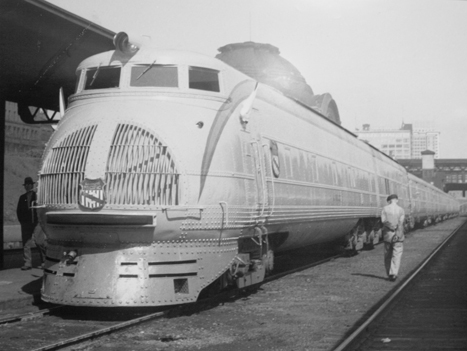
!["The nice thing about a [passenger] train is you can see what the country looks like -- you can look right out into people's backyards," says historian, author, and retired railroad employee Jim Fredrickson, who has amassed a collection of passenger train memorabilia. (PHOTO BY TODD MATTHEWS)](https://www.tacomadailyindex.com/wp-content/uploads/2008/07/070208_passenger_train1_web-150x150.jpg)
